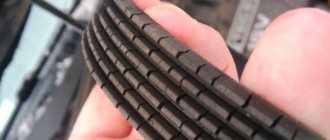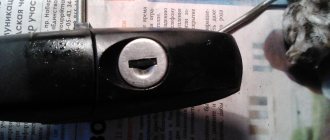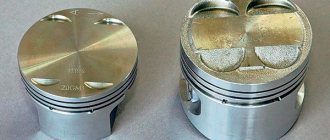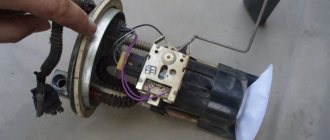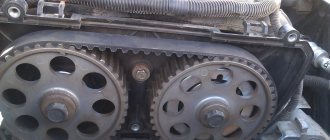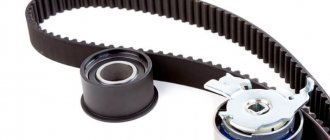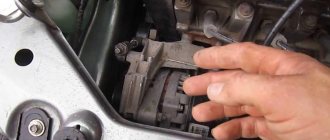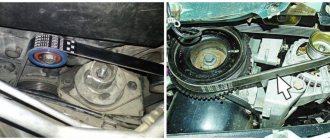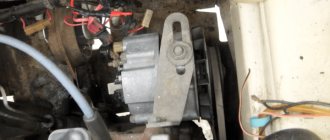The timing belts of any modern car are designed for not too much work. On average, it lasts about 50 - 100 thousand km, and after that it needs to be replaced along with the tension rollers, often even with the pump and pulleys. The service life of this element for each brand of machine is strictly specified in the technical documentation. However, if you follow them blindly, you may miss obvious signs of impending failure, which will lead to the need for expensive engine repairs. How to understand in time that the timing belt needs to be changed? To do this, you will need to understand a little about the principles of its operation and find out the main symptoms of defects. All photos below are shown exclusively from our practice.
Purpose and principle of operation of the timing belt
The timing belt is an extremely important element of modern cars. It is responsible for transmitting torque from the crankshaft to the camshaft or shafts, and also, depending on the make of the car, to the water pump. And on a car with a diesel engine, there is also a high-pressure pump.
The influence that the timing belt has on the engine is extremely great. So, in the case of an overextended drive, engine operation will be unstable: the idle speed “jumps”, the dynamics of the car decreases, the reaction when pressing the gas pedal is slower, the load on the belt teeth increases, and they eventually simply fly off, resulting in repairs motor. An overtightened belt does not affect the operation of the engine, but it can break at any time, and this is fraught with even bigger problems.
What types of timing drives are there?
Below are the types of timing drives that are found in automotive production:
- gear - common on old cars that have long been out of production;
- chain – looks like a metal chain;
- combined;
- belt drive - is the most popular drive, although it is inferior in reliability to most other types, but does not make noise and is much cheaper to manufacture than its analogues.
The number of rollers on the drive depends on the make and model of the car (some have 1, others have 2 or 3).
Signs of timing belt wear
The main obstacle to timely detection of belt failure is the difficulty of accessing it. Unlike attachment belts, the timing drive is securely covered by various covers. To carry out an audit or at least a visual inspection, partial disassembly of the engine is often required, and not every car owner can do this. However, in addition to visual inspection, possible defects in the assembly can also be determined by indirect signs. The most common ones are listed below.
Old timing belt
More often, the service life of timing drives is determined by the mileage of the vehicle. If it has traveled several tens of thousands of kilometers, then a replacement is definitely needed. However, that’s not all; for this element, a very important indicator is its age. The belt can be stored without loss of properties for up to five years, and after that it begins to crack and lose elasticity, no matter how long it has worked.
Car owners who rarely use their vehicle should take this moment seriously. This unit is made from materials that are subject to rapid aging and loss of their properties. For this reason, it is strongly recommended to replace the belt after purchasing a used car - after all, there is no guarantee that the previous owner was conscientious and followed the replacement regulations and used quality products.
Difficulty starting the engine. Reducing its power
If there is excessive wear or insufficient tension, the timing belt may jump one or more teeth. Which leads to ignition malfunctions - ignition of the fuel mixture will occur earlier or later than the required moment.
You can find out about such a defect by: “uncertain” engine starts, loss of traction and strong vibrations in the engine compartment. In this mode, the car can operate for quite a long time, but this leads not only to discomfort while driving, but also to more serious damage.
Heavy smoke from the exhaust system
First of all, this may indicate melting or complete destruction of the catalyst. This defect is caused by incomplete combustion of fuel in the engine. Due to a faulty ignition, the mixture partially enters the exhaust system through the valve, this entails a sharp increase in temperatures beyond the permissible limits and leads to honeycomb sintering.
The malfunction can be determined by observing the exhaust. If popping noises occur during engine operation, and black smoke begins to emit under certain operating conditions, this is a clear sign of incomplete combustion of the fuel mixture. Malfunction of the timing belt assembly is one of the common causes of such symptoms.
Ticking sound from the engine compartment
If the timing belt wears excessively, it begins to crack and eventually delaminate. During engine operation, this is characterized by various ticking, shuffling or clicking sounds that come from the side of the assembly casing. Noises occur with a certain frequency, depending on the engine speed - with their increase, the frequency of sounds increases.
Such a defect is not always associated with the timing drive. Noises may come from a jammed tension roller bearing or from the water pump. However, it wouldn't hurt to check the belt. To accurately determine, you will need to remove the drive cover.
Leaking from under the timing belt cover
Oil smudges or coolant leaks are a clear sign indicating a malfunction of this unit. Oil can get onto the belt from under a worn engine crankshaft oil seal, and coolant can get onto the belt due to insufficient sealing of the joints or from under the water pump pulley. In any case, this increases the rate of wear of the timing belt, and there is also a risk of it slipping on the pulleys. In this case, you will need to disassemble the unit and replace the belt with a new one. In addition, if the pump is leaking, this indicates that soon its bearing will fall apart and the shaft will jam, which will lead to a break in the timing belt and all the ensuing consequences.
Cracks and abrasions in the timing belt
If you have access to the timing drive, then you can inspect it. To do this, you need to put the car in gear and smoothly turn the crankshaft by hand, after hanging one of the wheels and unscrewing the spark plugs. If even the slightest signs of wear are detected, the part must be replaced, even if it has not yet exhausted its service life.
It is quite difficult to visually determine how badly the belt is worn. Even a seemingly normal drive can break when you try to twist it.
The engine cannot be started, the starter turns idle
If the belt breaks, it will not be difficult to identify it. When you turn the key, the starter works very vigorously, even better than usual, but at idle. The mixture in the cylinders does not ignite and the engine does not start. This is a clear sign of a lack of compression caused by the bending of the valves after meeting the pistons.
In some cases, such a motor ends up in a landfill. But in most cases, you can get by with simply replacing the valves with lapping, but it will still be very expensive.
After how many thousand km does it need to be changed?
The consumable does not have a regulated shelf life. At what mileage the timing belt is changed cannot be answered unequivocally. The lifespan of its operation is influenced by the following factors:
Malfunction of other elements of the internal combustion engine system and high dynamic loads also affect how many kilometers the timing belt will need to be changed.
If the car has driven another 50,000 kilometers, they buy new consumables. The instructions may indicate a different period for its safe operation, but the manufacturer assumes that the car will be driven under ideal conditions.
Also, the decision to replace depends on the country in which the car was assembled. In new domestic vehicles, this element wears out after 50 thousand km, and in foreign cars - after 70 thousand km. If the car is not from the showroom, then for 30,000 and 50,000 kilometers, respectively.
In winter, drivers often warm up their car before driving off. The timing belt runs idle, the speedometer readings do not change. It is important to take this into account in order to change consumables as needed, and not at predetermined times.
Timing belt replacement interval
Regardless of the timing indicated for replacing the belt in the technical passport attached to the car, in case of severe wear or damage, it should be replaced with a new one. For example, on most domestically produced cars, the working life of the timing belt is 120 – 160 thousand km. However, experienced car owners understand that the figure is twice as high.
In particular, the wear rate of the timing belt, and the vehicle itself, depends on several factors. Namely:
- quality of road surface;
- The model of car;
- drive manufacturer;
- the quality of its material.
In addition, when driving in urban conditions, the car often gets stuck in traffic jams. At this time, the mileage counter does not move, but the engine and other components continue to work and, accordingly, wear out. It’s also worth adding starting a cold engine in winter. It is more difficult to unwind it, more force is required, which means more load is placed on the belt and rollers.
If a car travels about 15 thousand km per year on average, then the belt should be replaced approximately once every three years. Or 40 - 45 thousand kilometers. It is important to remember that if it breaks, repairs will require spending many times more than the cost of the belt.
To summarize, we can say that the service life of the timing belt depends on the following factors:
- presence of oil leaks from the crankshaft and camshaft;
- wear of these components;
- condition of the rollers and correct adjustment.
It should be understood that when replacing the timing belt, it is recommended to install a new water pump, pulley and tension pulley.
Let's sum it up
As you can see, the timing belt is an important and critical element in the overall drive mechanism of the gas distribution mechanism. At the same time, this solution is easier and cheaper to maintain than a chain drive, but belt drive elements must be replaced more often. Moreover, it is better to reduce the replacement intervals recommended in the manual by at least 25-30%.
We also recommend reading the article about why the engine does not start after replacing the timing belt. From this article you will learn about the main reasons why the internal combustion engine does not start or is unstable after the timing belt has been replaced.
It is also necessary to periodically monitor the condition of the belt, pay attention to extraneous sounds in the timing drive, etc. In this case, it is possible to avoid unexpected belt breakage or jamming of rollers, which also often leads to breakage and/or bending of valves.
Finally, we note that only strict adherence to the above rules and recommendations allows you to avoid unexpected breakdowns and significantly reduce the risks of breaking the timing belt and bending the valves.
Urgent timing belt replacement
In what case should urgent repair of the timing belt unit be carried out:
- The appearance of extraneous noise from the drive casing. To do this, you will need to remove the belts of all additional equipment. If the sound is still heard, then it is necessary to remove the protective cover, and then check the belt, water pump and rollers.
- The appearance of fluid leakage from the timing belt casing. As already mentioned, if foreign liquids get on the belt, its strength decreases and the possibility of slippage and even breakage increases.
- When examining the belt, obvious signs of wear were found - abrasions, cracks between the teeth on the inside of the drive, delamination of the blade and teeth, the presence of traces of rubber dust on the casing and other adjacent parts.
If at least one of these defects appears, the belt should be urgently replaced and, if necessary, the causes of this situation should be eliminated. If this is not done in time, in the event of a break, the engine will be completely damaged.
Analysis of timing belt defects
Assessing and identifying the circumstances that caused timing belt defects:
- the presence of tears and fraying of the drive indicates excessive tension on the unit;
- one or more teeth are cut or worn out - weak tension;
- the appearance of a large number of cracks is a sign of exposure to high or low temperatures, possibly aging of the product;
- the belt is worn between the teeth - the tension is incorrectly adjusted;
- the presence of severe abrasions on the end - distortion;
- Excessive noise - the belt is too tight or too tight (urgent adjustment is required to avoid breakage).
If a timing belt defect is detected, it is better to immediately eliminate the cause and, if necessary, install a new drive. It is not that expensive, but if it breaks, you will have to spend a lot of money on repairing the car.
What causes a broken timing belt?
The timing belt performs a very important function - ensuring contact between the crankshaft and the camshaft. This ensures synchronous operation of the valves with the pistons. The drive rotates the camshaft at half the speed of the crankshaft.
In most engines, valves and pistons are located in one block. Only the timing belt protects them from a collision. And if it breaks, the pistons hit the valves, bending them. Almost all cases lead to the need for engine overhaul.
On many modern cars, the valve stem may be destroyed (if you're lucky), in the worst case, the pistons will need to be replaced (more often applies to diesel engines).
A broken timing drive leads to:
- serious damage to the internal combustion engine;
- failure of the generator - in this case, the battery does not recharge and runs out completely, as a result, all the electronics of the car stop working;
- failure of the power steering - driving becomes more difficult.
In addition, the water pump drive may break. In this case, the motor overheats, which also leads to serious damage.
Daewoo
| Engine (l) | Broken timing belt | Mileage (km) |
| 1.5 | No damage | 95,000 |
| 1.6 | No damage | 95,000 |
| 2.0 | Damage | 115,000 |
| 2.0 (California) | Damage | 165,000 |
| 2.2 | Damage | 115,000 |
| 2.2 (California) | Damage | 165,000 |
Tired of paying fines? There is an exit!
Forget about fines from cameras! An absolutely legal new product - Traffic Police Camera Jammer, hides your license plates from the cameras that are installed in all cities. More details at the link.
- Absolutely legal (Article 12.2);
- Hides from photo and video recording;
- Suitable for all cars;
- Works through the cigarette lighter connector;
- Does not cause interference to radios and cell phones.
Order with a discount
